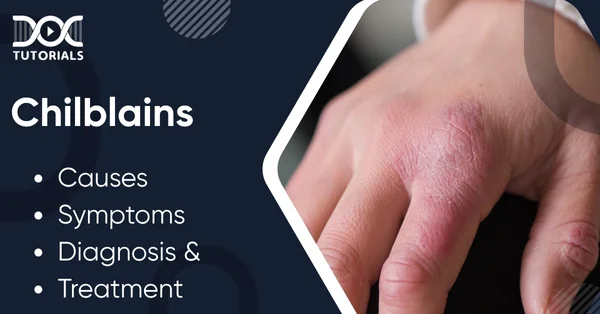Chilblains: Causes, Symptoms, Diagnosis, and Treatment

Women are more likely to develop chilblains, particularly those between the ages of 15 and 30, and those with a low body mass index. Studies show that this inflammatory skin ailment is particularly common in those who have been exposed to cold temperatures. Chilblains also tend to occur more frequently in individuals with viral infections, such as COVID-19, or autoimmune diseases.
If you are a NEET PG aspirant or work in medicine, learning more about chilblains can help you better understand and diagnose potential patients.
Want to know more? Let’s get going!
What Are Chilblains?
Chilblains, sometimes called pernio, are little, irritating bumps on the skin that happen when it’s cold. They typically affect the body’s extremities, such as the fingers, toes, ears, and nose. This medical problem usually happens when the skin is exposed to cold and then quickly warmed up again. This makes blood vessels expand quicker than smaller neighbouring vessels can manage.
As a result, blood seeps into the surrounding tissues. If they don’t get any colder, they normally go away in a few weeks.
What Causes Chilblains?
We don’t know exactly what causes chilblains; however, there are a few things that make them more likely to happen:
Chilblains can happen when your body reacts strangely to cold and then warms up again.
Inflammation of Small Blood Vessels: When you are outside in the cold, tiny blood vessels can become inflamed, resulting in painful sores on the skin.
Some things that can make chilblains more likely are:
Tight or Poorly Fitting Clothes: Wearing clothes and shoes that are too tight in cold, damp conditions may increase your risk of developing chilblains. This could also happen if you don’t wear the appropriate attire in these situations.
Demographics: Young women, especially those between the ages of 15 and 30, are more likely to be impacted.
Low Body Mass: If you are underweight, your risk of complications increases.
Climate: If you live in a cold, wet place, you are more likely to get chilblains.
Chilblains can happen for no known reason, but they can also be linked to other health problems, including lupus, Raynaud syndrome, or vasculitis.
What Are The Signs Of Chilblains?
Chilblains symptoms typically appear a few hours after exposure to cold but not freezing weather. Here are some of the signs:
- Itchy spots on the skin that are small and usually on the hands or feet.
- Swelling
- Pain or a sharp feeling
- The colour of the skin changes to blue or red
- Shiny look because of swelling
- Bumps
- Feeling like it’s burning
If symptoms last longer than two weeks, come back often, or there is a reason to believe there is an infection, it is best to see a doctor.
How Do Doctors Figure Out If Someone Has Chilblains?
To diagnose chilblains, doctors look at the patient and sometimes do more tests to be sure it’s not something else:
Clinical Evaluation: Healthcare professionals look at the afflicted skin areas and ask about symptoms and recent exposure to cold places.
Medical History: A thorough patient history helps figure out how long and how often symptoms occur, as well as any underlying health problems that may be making them worse.
Physical Examination: It looks for indications that are typical, like red or purple spots, swelling, and potential blisters on the fingers and toes.
Differential Diagnosis: It’s important to tell chilblains apart from other illnesses that look like them, like frostbite, lupus, or Raynaud’s syndrome.
A skin biopsy may be done to look at tissue under a microscope in circumstances where the diagnosis is not clear. This can assist in confirming the diagnosis or rule out other illnesses.
Blood Test: If you have chilblain-like symptoms, your doctor may order lab tests like a complete blood count and autoimmune markers to find out whether you have any underlying systemic illnesses that could be causing them.
Capillaroscopy: This technique looks at the little blood vessels (capillaries) in the skin without cutting into it to find any problems that could help with the diagnosis.
How Do You Treat Chilblains?
The goal of chilblain treatment is to alleviate symptoms and prevent recurrence. Here are some ways to do that:
How to Take Care of Your Chilblains
- Slowly warm up the areas that are affected, and stay away from direct heat sources like heaters or hot water.
- Wear the right clothes to keep your skin warm and dry.
- To stop the itching, use moisturisers or calming lotions like hydrocortisone, chilblains cream or calamine.
- Don’t scratch to keep your skin from getting hurt and maybe infected.
Medications
Corticosteroids applied to the skin, such as triamcinolone 0.1% cream, may be used to help alleviate itching and swelling.
Nifedipine, a calcium channel blocker, is one of the oral chilblain drugs that can help blood flow and is used in cases that last a long time or are really bad.
Ways to Stop It from Happening
- Avoid areas that are cold and wet, and wear multiple layers of warm clothing.
- Warm up skin slowly after being in the cold to keep it from happening again.
- Stop smoking since nicotine narrows blood vessels and can make symptoms worse.
FAQs About Chilblains
- Is it usual to have chilblains?
Chilblains are a typical cutaneous reaction to cold temperatures, especially in persons who don’t have good blood flow. They usually only affect the toes, fingers, nose, and earlobes. They are relatively uncommon and will go away with time and the right care, even though they are uncomfortable.
- Is there a way to treat chilblains?
Yes, chilblains usually get better when you take care of yourself by keeping the affected regions warm and dry. If the symptoms don’t go away, doctors may suggest drugs to help ease the pain.
- Are chilblains harmful?
Chilblains aren’t usually significant and go away on their own without causing any long-term problems. They can cause discomfort and itchiness, but they typically improve within one to three weeks.
- Can kids get chilblains?
Chilblains can happen to kids, especially if they are in cold, wet places without enough protection. Ensuring kids are dressed appropriately for the weather will help prevent chilblains from occurring.
- Can I go about my daily life with chilblains?
Of course. Chilblains can be painful, but they can be treated with the right care. Most people can continue their daily activities as long as they take steps to keep the affected areas warm and dry.
Conclusions
It is crucial to understand what causes chilblains, recognise the symptoms, and know how to treat them. DocTutorials provides students like you preparing for NEET PG with access to a wide range of subjects, including medicine, anatomy, dermatology and venereology, pharmacology, and more.
You can also use short video lectures, live discussions with specialists, high-yield notes, and question banks that have been reviewed by academics to be ready for the next level.
Find out more about our NEET PG study materials to make your learning better!
Latest Blogs
-

NEET SS Exam 2024: Analysis, Key Dates, Counselling
The NEET SS 2024 exam kicked off on March 29, 2025. Over two days and two slots, candidates across 13…
-

NEET PG Registration 2025: An Essential Guide For Exam Prep
The NEET PG registration, which is conducted online, is a crucial step in the exam process. Filling out the NEET…
-

NEET PG Syllabus 2026: A Must-Have Complete Guide for Exam Success
The NEET PG Syllabus acts as one of the foundation stones for aspiring postgraduate medical students like you who are…




